State-Sponsored Rallies in Iran As Gov't Downplays Israeli Attack
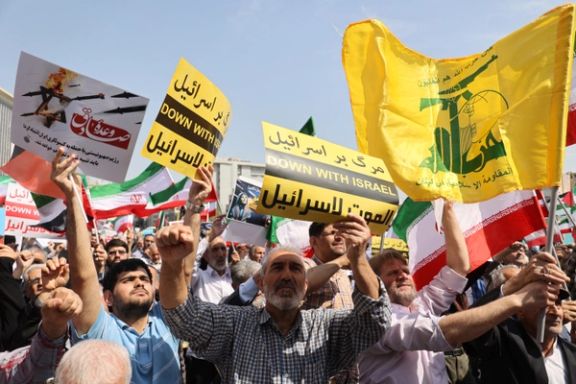
State-sponsored anti-Israeli rallies took place in multiple cities in Iran after Friday prayers.

State-sponsored anti-Israeli rallies took place in multiple cities in Iran after Friday prayers.
Rallies were held in multiple locations in the Tehran province and in Mashhad, North East of Iran, and the North West in Zanjan.
Iranian regime-affiliated media outlets reported on today’s rallies without mentioning Friday's attack on an airbase in central Iran, reportedly launched by Israel. These outlets described the purpose of rallies to be in support of “Vade-ye Sadeq”.
Vade-ye Sadeq (Operation True Promise) is the codename the Iran Revolutionary Guards Corps (IRGC) gave to the Iranian missile and drone attack on Israel on April 14 in response to the alleged Israeli attack on its embassy in Damascus on 1 April.
The rallies being pre-organized state-sponsored events and presented as being in support of Operation True Promise, were part of the Iranian regime’s propaganda to justify its attack on Israel on April 13.
Reports of explosions near both the airport and an army base in Isfahan province, situated in the central region of Iran broke earlier Friday. While US officials have stated that Israel was behind the attack, Iran has continued to downplay the attack.
Furthermore, the only remarks by Iranian officials about the Friday attack did not even mention Israel. Before Friday's prayers sermon, commenting on the attack, Kioumars Heydari, Commander of the Iranian Army's Ground Forces stated: "If suspicious flying objects appear in the country's sky like last night's incident, they will not be spared from being targeted by our defense forces."
Additionally, Friday prayer imams, appointed by Supreme Leader Ali Khamenei, did not mention the Friday Israeli attack in their sermons.

Almost a week after Iran attacked Israel, Iran’s former foreign minister is speaking out about the strikes, suggesting that “inaction” by the UN Security Council forced Tehran to act.
“Israel's recurring acts of aggression against Iran, especially its provocative attack on Iran's diplomatic premises in Syria, went unpunished by the UN Security Council, compelling Iran to take a measured response in self-defense targeting only military facilities and—unlike Israel—intentionally avoiding civilians,” Javad Zarif wrote on X.
“Now, in light of today's reckless fireworks in Esfahan, all countries and leaders should focus on ending Israeli transgressions, particularly its war on Gaza. The US veto of the UNSC resolution on Palestine's UN membership was clearly a step in the wrong direction,” he added.
On Friday, Israel conducted airstrikes on Esfahan, a significant city in central Iran known for its nuclear facilities.
Iranian authorities and media have reported that Friday’s attack caused no damage.
Israel has not taken responsibility for the incident, but had previously promised to retaliate after a missile and drone attack from Iran on its territory last weekend.
Iran had been on high alert following Israel's announcement that it would retaliate against the attack from Iran, during which over 300 projectiles were launched at Israel—99% of which were intercepted and shot down.

An air defense facility in southern Syria was targeted early Friday with a missile purportedly fired from Israel, causing material damage.
Syrian state media reported that the airstrike hit the air defense installation in the southern province of Daraa early Friday.
“At around 2:55 am this morning, the Israeli enemy launched a missile attack from the north of occupied Palestine, targeting our air defense sites in the southern region [of the country]. The aggression resulted in material damage,” SANA quoted a military source as saying.
The UK-based Syrian Observatory for Human Rights (SOHR) said some loud blasts were heard in the countryside of Daraa during the early hours of Friday, linking them to a possible Israeli airstrike that targeted an air defense radar between the city of Izraa and Qarfa town.
Observatory head Rami Abdel Rahman said six Israeli fighter jets were seen entering Syrian airspace and heading east. Rahman also said the jets were flying eastward when they were picked up by the radar.
This strike came as news of an airstrike on the Iranian city of Isfahan was carried out by Israel —a major city in which several sensitive nuclear facilities are based.
While Iran-backed groups operate out of Syria, It is unclear whether the strikes are directly linked to the Isfahan explosions.
The state news agency IRNA reported early Friday that "Iran's air defense systems were activated in the skies over multiple provinces". This came after the state broadcaster IRIB reported hearing "large explosions" near Esfahan.
US officials have since confirmed in multiple reports that Israel carried out the strike, though the scope of damage has yet to be confirmed.
This latest news followed Iran’s drone and missile attack on Israel last weekend – the first-ever direct assault on the country. Iran says that strike was in response to a widely-believed Israeli attack on an alleged Iranian consulate in Damascus earlier this month.
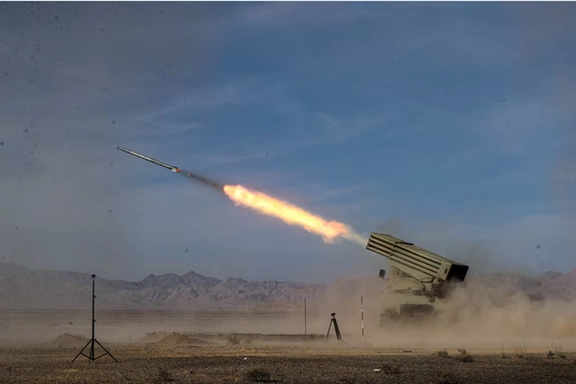
Explosions were heard near the central-western city of Isfahan early Friday as Israel reportedly launched a widely anticipated strike in retaliation to an Iranian attack over the weekend.
State-run IRNA news reported the "activation of anti-aircrafts'' in Esfahan's 8th Shekhari Air Base Base while downplaying the situation as "normal." Meanwhile, flightradar24.com showed that for hours after the incident, Iranian air traffic was lower than usual.
Iranian officials have not officially confirmed the attack was carried out by the Israelis and merely said Esfahan's air defenses have targeted several “micro-birds and suspicious objects”.
US officials confirmed to ABC News that three missiles were fired from Israeli fighter aircraft outside of Iran. "The Israelis were targeting an air defense radar site near Esfahan that’s part of the protection of the Natanz nuclear facility," an official said. "The first assessment is that the strike took out the site, but assessment hasn’t been completed," the official said.
A report in the New York Times quoted two Israeli and three Iranian officials who said the Israeli army had launched an attack on Iranian targets. The NYT further reported that Iranian officials confirmed to them that a strike had hit a military air base near Esfahan.
Bloomberg wrote that Israelis had notified US officials before the attack.
The Italian foreign minister stated that the US informed the G7 foreign ministers that it had received "last-minute" information from Israel about an upcoming operation in Iran.
US Secretary of State Antony Blinken declined to comment on the overnight attack in Iran, stating that Washington does not participate in any offensive operations.
Around the same time as the incident in Iran, Syria's SANA news agency reported Israel had fired missiles at an air defense unit in the country’s south, which is directly west of Esfahan, some 1,500 kilometers away. Syria's Observatory for Human Rights reports that the strike targeted a military radar used by the government.

With Iranian state media confirming that the antimissile system was activated at Esfahan's 8th Shekari Air Base, and US media confirming its significance as a major air base, attention is inevitably focused on that specific location.
It is one of the 17 active air bases of the Islamic Republic Army, known as the "heart of the country's air defense" due to its location in one of its most central parts. Iran's fleet of F-14 Tomcat aircraft—purchased before the 1979 Islamic Revolution—is headquartered at this base.
Farzin Nadimi, a Senior Fellow with The Washington Institute, told Iran International besides two military bases, Esfahan is home to the Shahed Aviation Industries Research Center, which manufactures the Shahed-136 drones.

Esfahan is also home to sites associated with Iran's nuclear program, such as its underground Natanz enrichment site, which Israeli sabotage activities have purportedly repeatedly targeted.
After the incident, state television described all the area's nuclear sites as "fully safe."
The United Nations' nuclear watchdog, the International Atomic Energy Agency, also stated there had been no damage to Iran's nuclear facilities.
Although there are no official reports of what type of weapons were used during the attack, experts have speculated what might have occurred.
Nadimi, who specializes in security and defense affairs, told Iran International that Israel would not use regular or laser bombs to carry out the attacks as they have done in the past. Since 2015, the Israeli military has possessed missiles with a range of 1,500 kilometers that can be launched from aircraft, which means they can be fired without entering the Esfahan anti-aircraft airspace.
According to the Jerusalem Post, long-range missiles were used in the attack to avoid Tehran's radar detection capabilities, debunking Iran's claims that "micro drones" were used.
It’s worth mentioning that Reuters quoted a senior Iranian official who said the attack might be by "infiltrators" rather than by Israel.
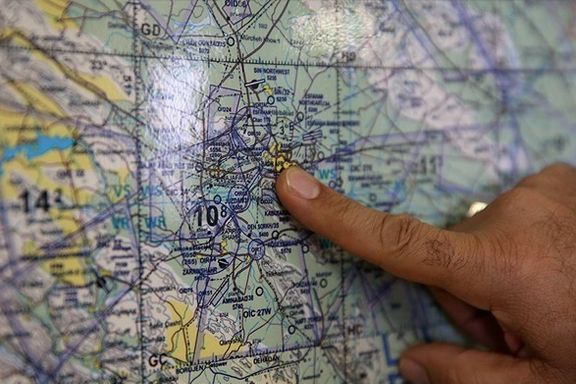
Iran launched over 350 projectiles on Saturday night following the alleged April 1 Israeli air strike on the Iranian consulate in Damascus in which two senior IRGC commanders were killed along with several others.
Some experts believe the relatively small scale of Friday's attack may be attributed to pressure exerted by the US and its allies, as well as the fact that Israel is engaged on other fronts with Hamas and Hezbollah.
An unnamed Israeli official told the Washington Post that the attack "was intended to signal to Iran that Israel had the ability to strike inside the country".
Some analysts have taken a different stance, comparing the aftermath of the attacks rather than how they were carried out.
Menashe Amir, a Middle East affairs analyst, told Iran International that the attacks are comparable: Iran intended to target the Nevatim Airbase, and Israel also attacked a military base in return. The difference is that Iran had to make extensive use of artillery while Israel did not have to, which shows the superiority of Israel's military power.
According to Amir, the attack fits the doctrine the Israeli military has always pursued: not to engage in war on several fronts.
Political analyst Hessam Dastpish told Iran International that both Iran and Israel achieved their respective objectives through the use of their respective methods of conflict. Iran created a massive scene to satisfy proxy groups, while Israel wanted the support of the US and allies, so under their pressure, it pursued a different strategy.
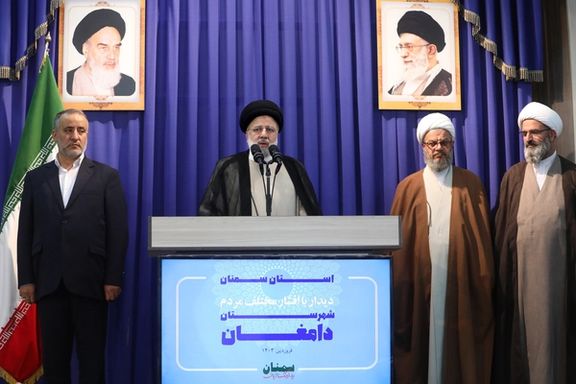
Iranian President Ebrahim Raisi avoided addressing Israel’s attack on the country on Friday, opting instead to praise Tehran’s own attack on Israel last week.
Raisi described the recent attack on Israel as a “unifying” event that was supported across all Iranian political factions.
"All groups and political streams believe that the attack on Israel was a necessary action, unifying and a great honor for the country," Raisi stated during a visit to Damghan in central Iran.
His comments come as the Islamic Revolutionary Guards has put pressure on media and journalists not to write or publish anything critical of Tehran’s attack on Israel last weekend.
The IRGC-linked Tasnim News Agency published a statement on X earlier this week that said the Guards were about to start "to deal with Israel's supporters on social media."
The statement called on citizens to turn in those who support Israel on social media.
While multiple reports confirmed that Israel had carried out an airstrike – the Iranian government quickly downplayed the claims, suggesting instead that the explosions were caused by the interception of microdrones by Iran's air defenses, attributing the incident to "infiltrators".
Tehran appeared to indicate that it has no plans for retaliation, in a likely bid to avoid a full-scale war with Israel.
That stance was echoed by a senior Iranian official who spoke to Reuters, who said "the foreign source of the incident has not been confirmed. We have not received any external attack, and the discussion leans more towards infiltration than attack".
Israel has not yet confirmed its role in the attack on Iran, although it had previously announced intentions to retaliate.
Iran’s attack on Israel last weekend saw over 300 drones and missiles launched, with 99% of them intercepted by Tel Aviv and its allies.
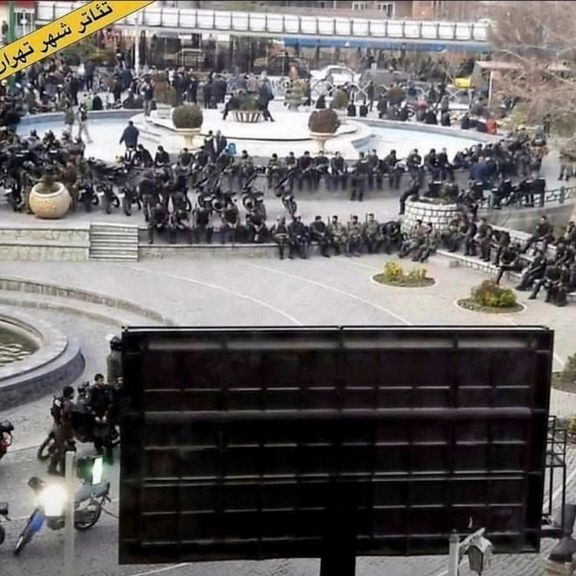
Traffic analysis on X reveals that Iranians have significantly tweeted more about the recent escalation of the hijab crackdown than about the heightened tensions between Iran and Israel.
Iranian media Thursday widely reported that the number of Persian tweets about tensions with Israel rose to nearly 6,000 on Tuesday when less than 2,000 users tweeted about the hijab crackdown.
On Wednesday, however, after a host of videos of harsh treatment of women and violent arrests by the morality police emerged on social media, tweets about hijab rose to around 7,000 and those addressing the tension with Israel dropped to a little over 2,000.
The violence used against women, in the past few days has angered many Iranians from every walk of life including those who support or praise Iran's missile attack against Israel last weekend as retaliation for Israel’s strike on the Iranian embassy in Damascus on April 1.
“Israel says it wants to attack but hardliners in Tehran have deployed the morality police battalions and are shutting down coffee shops like a dominos,” Mostafa Faghihi, chief editor of the conservative Asr-e Iran news website tweeted. Calling those responsible for the crackdown against women “ignorami” who fight Iranian women instead of Israel.
In the hours leading up to Saturday's missile and drone strike on Israel by the IRGC, Iran's morality police intensified their efforts against unveiled women. Additionally, Iranian authorities initiated crackdowns on media and social media activists.
The police force’s infamous “guidance patrols”, often referred to as the “morality police”, have returned to the streets, Tehran’s metro stations, and other cities across the country in full force, to enforce the Islamic dress code.
The patrols consisting of male and female uniformed police personnel as well as plainclothes agents have arrested hundreds of women and in at least dozens of cases women the arrests, as videos and reports on social media attest, were very violent.
Iran International has spoken to several women who say they were assaulted, verbally abused, and sexually harassed by arresting morality police officers and plainclothesmen who helped them.
One of the detainees, a 17-year-old girl, recounted to Iran International her violent arrest at Tehran's Daneshjoo Park. She described police officers pulling her hair, striking her arms and thighs with a baton, and directing sexual slurs at her. Moreover, she stated that women who resisted arrest, mostly very young, were assaulted by an officer while in the police van.
A 19-year-old woman who was also arrested violently told Iran International that at a detention center plainclothes officers tased her in the stomach and genitals, hurled sexual profanities at her and her family members.
Both females were forced to provide full details about themselves and their family members, including their phone numbers before being released.
Citizen reports on social media also allege that many girls detained by the morality police were minors as young as twelve years old.
During his election campaign, President Ebrahim Raisi had promised to clampdown on government officials for inefficiency and corruption instead of the so-called “[Moral] Guidance Patrols” for hijab.
"Khamenei acknowledges the increasing courage of Iranians in challenging the ruling establishment's beliefs and imposed red lines," said Iman Aghayari, a journalist and political analyst based in Turkey. "He refers to the 'imposed challenge of hijab' and, in a play on words, disguises his aggressive stance towards society as a form of defense," Aghayari told Iran International.
Authorities say they are fighting against behavior that is "against the society’s norms" but what they refer to as abnormality is in fact the lifestyle that people have chosen and is completely normal for most Iranians, Aghayari added.
“With the summer approaching, when more women shed their long headscarves, and the anniversary of the Woman, Life, Freedom movement drawing near, the hijab challenge is likely to intensify in the coming months, too,” he said.






